-
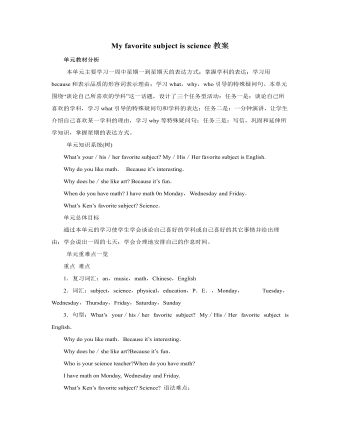
人教版新目标初中英语七年级上册My favorite subject is science教案
本单元主要学习一周中星期一到星期天的表达方式;掌握学科的表达;学习用because和表示品质的形容词表示理由;学习what,why,who引导的特殊疑问句。本单元围绕“谈论自己所喜欢的学科”这一话题,设计了三个任务型活动:任务一是:谈论自己所喜欢的学科,学习what引导的特殊疑问句和学科的表达;任务二是:一分钟演讲,让学生介绍自己喜欢某一学科的理由,学习why等特殊疑问句;任务三是:写信,巩固和延伸所学知识,掌握星期的表达方式。单元知识系统(树)What’s your/his/her favorite subject? My/His/Her favorite subject is English.Why do you like math. Because it’s interesting.Why does he/she like art? Because it’s fun.When do you have math? I have math 0n Monday,Wednesday and Friday.What’s Ken’s favorite subject? Science.单元总体目标通过本单元的学习使学生学会谈论自己喜好的学科或自己喜好的其它事情并给出理由;学会说出一周的七天;学会合理地安排自己的作息时间。

人教版新目标初中英语七年级上册What time do you go to school教案
知识与能力复习词汇time,morning,breakfast,get up,g0 t0 bed,homework,clock,afternoon,lunch,run,watch TV,evening,dinner,eat,usually,o’clock,thirty,fifteen,take a shower,go t0 school等;引导学生复习、巩固“询问和谈论时间”的目标语言并运用所学知识安排自己的学习和课外活动。过程与方法运用Summarizing,Classifying和Comparing的学习策略。在复习教学中,运用听写、提问、对话演练与调查活动,促使学生不断地使用所学内容,从而提高他们灵活运用知识的能力。情感态度价值观本部分的主要内容是复习“日常作息时间”的询问和表达。通过互相询问或谈论自己或对方的作息时间安排和活动计划,培养学生良好的作息习惯和守时习惯。教学重、难点及教学突破重点复习词汇time,morning,breakfast,get up,g0 to bed,homework,clock,afternoon,lunch,run,watch TV,evening,dinner,eat,usually,o’clock,thirty,fifteen,take a shower,go to school等;引导学生复习、巩固“询问和谈论时间”的目标语言。
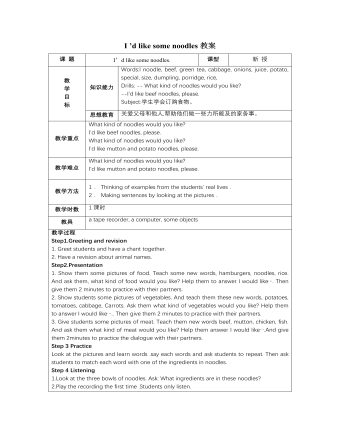
人教版新目标初中英语七年级下册I ’d like some noodles教案
教学过程Step 1: warming-up Sing a song---------“food and drink” Step 2: Revision1 Dictation2 Revise: What kind of noodles would you like?I’d like …What size bowl of noodles would you like?I’d like…Step 3: Presentation1 show pictures of food, ask students say the words.2 Students read the newspaper ad in 3a. Fill in blanks with words in the box. Then read the ad together, the teacher explains some difficult language points.3 Check the answers Step 4 PracticeAsk students to finish 3b in the same way according to 3a. Students read the short passage and fill in the blanks .At last, check the answers.Step 5 productionAsk students to write their own ad for dumplings, noodles, drinks, and other foods they know. Then ask students to read their partner’s ad. Then order food and drink from their partner.Step 6 Home workGroup work – make an ad about “food and drink”
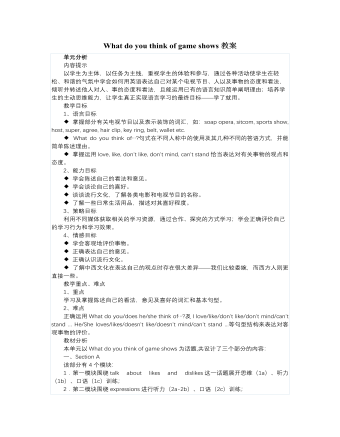
人教版新目标初中英语七年级下册What do you think of game shows教案
五、教学Section B-2c1. Pair work: What do you think of the belt/sunglasses/…? What does your father/mother/… think of your scarf/belt…?2. Group work(1). Teacher shows some different kinds of school uniforms (制服)and asks : “ What do you think of your school uniforms? If you have a chance to choose your school uniforms, what kind would you like to choose?”(2). Discuss in groups.(3).Get some Ss to report in class.说明:这一步旨在让学生运用已有的语言知识谈论对事物的看法和意见,并简单阐明理由,培养学生的主动思维能力和运用英语的能力。六、教学拓展调查电视节目的收视率任务:调查你周围的人对现在各种电视节目的反响。活动过程:1.教师布置任务,让学生调查周围的人(包括他的亲戚朋友和邻居)喜欢收看哪方面的电视节目。2.学生进行调查活动,运用本单元所学的句型What do you think of….? (Why?)What's your favorite game shows?What do you think of talk show?I doesn’t mind it.I like it.I love it.I can’t stand it.3.记录下排在前10位的TV Program,填写调查表,比较其收视率。

人教版新目标初中英语八年级下册Have you ever been to an amusement park教案
(1)Have you ever been to …? Yes, I have. / Yes, I have ever been to …No, I haven’t. / No, I have never been to …(2)When did you go there? I went there last year. (3)I have never been to a water park. Neither have I. I have ever been to an amusement park. So have I. (4)How long have you been studying English? I’ve been studying English since nine o’clock. I’ve been studying English since I came back home. I’ve been studying English for five hours. (5)What’s that? It’s an amusement park in Japan. I’ve never been to an amusement park like it before. It’s fun to learn another language. Let’s go tonight. Isn’t this great?space museum, amusement park, water park, South America, Peru, Holland, European culture, tour guide, flight attendant, musical instrument, more than, be from, get to, take lessons, neither, discover, graduate, change
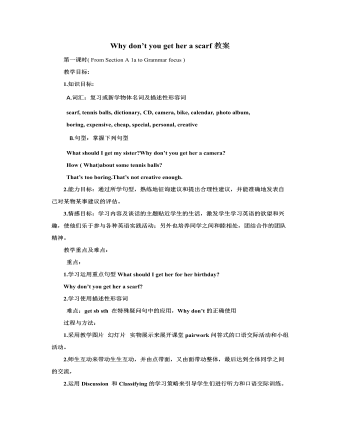
人教版新目标初中英语八年级下册Why don’t you get her a scarf教案
教师带领学生复习有关描述宠物的词汇,采用教师提问学生回答的方进行。如:T:What animals do you think would be good pets?What animals do you think would be bad pets?What do you think are good animals for a six-year-old child?然后学生进行 pairwork 练习。Task two: 师生互动,学习探究 1、播放3a部分的录音,引导学生一边听录音,一边跟读。2、通过听录音学生回答以下问题:Why do you think pot-bellied pigs are popular?What are the advantages and disadvantages of keeping such a pet?教师对学生的回答进行及时点评。3.学习范文,学习重点短语,为下步的模仿写作提供语言素材。T :1. )Have you ever kept a pig as a pet?Do you like pigs? St.:No.…Why don’t you like to keep a pig? St: No.They’re too dirty and lazy(Do you know in some foreign countries like Hollyland, Australia,pigs are the most popular pet.there’s a kind of pig.(图)it has an interesting name? it ‘s called a pot-bellied pig.) Now,let’s learn an article about this kind of interesting pet.2.)play the tapeSt.:Listen and repeat3.)show some Qs on computer(本子St.: read silently,then answerthe Qs(本子)4.)Ask ss. Close book and retell this passage.(what is a pot-bellied pig? Is it a good or bad pet? ) St.: retell it to each other“A pot –bellied pig is a popular pet now…”5.read the article together.St.:.practice reading
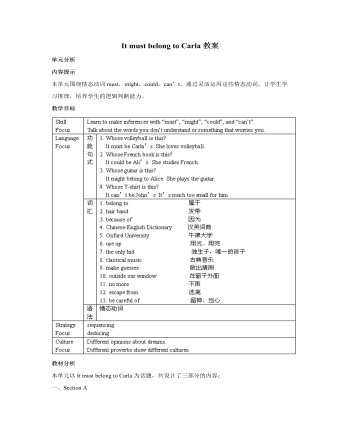
人教版新目标初中英语九年级上册It must belong to Carla教案
一、Section A该部分有4个模块。第一模块围绕Whose volleyball is this? 这一话题展开思维( 1a)、听力(1b)、口语( 1c)训练;第二模块围绕上一模块中的话题进行听力( 2a-2b)、口语训练( 2c);第三模块继续围绕前两个模块中的“making inferences”展开训练。训练形式为阅读排序( 3a)和两人问答(3b);第四模块仍就上一话题展开讨论。二、Section B该部分有4个模块。第一模块要求根据图画和所提供的单词写出合理的句子;第二模块在听力( 2a-2b)和分角色口语训练( 2c)的基础上,继续进行“推测”训练; 第三模块围绕“Strange events in Bell Tower neighborhood”这一话题展开阅读( 3a)和写作(3b -3c)训练;第四模块以dream为话题展开小组活动。三、Self Check该部分有3个模块。第一模块以填空形式对所学词汇进行训练;第二模块就8个谚语展开阅读和讨论。

人教版新目标初中英语九年级下册Rainy days make me sad教案
1. 教材分析本单元以how do things affect you?为话题, 从颜色、天气、音乐、广告、产品等方面谈论了外界事物如何影响人的心情。要求学生掌握表达某物或某事给人带来的感觉、看法或影响等。共设计了四个部分的内容:Section A 该部分有4个模块:第一模块围绕Which restaurant would you like to go to?这一话题展开思维(1a)、听力(1b)、口语(1c)训练;第二模块围绕How does music affect you? 进行听力(2a-2b)、口语训练(2c);第三模块继续围绕how do colors in the restaurant affect you这一话题展开训练,训练形式为阅读和问题体验(3a)和小组活动(3b);第四模块仍就How do things affect you这一话题以调查的形式展开讨论。Section B该部分有4个模块:第一模块围绕产品广告对人们的影响这一话题以“配对”(1a)与“列举”(1b)两种形式展开训练;第二模块继续围绕How do things affect you? 进行听力(2a-2b)、口语对话训练(2c);第三模块围绕“Advertising”这一话题展开阅读(3a-3b)和写作(3c)训练;第四模块围绕How posters affect you这一话题以口语训练形式展开小组活动。
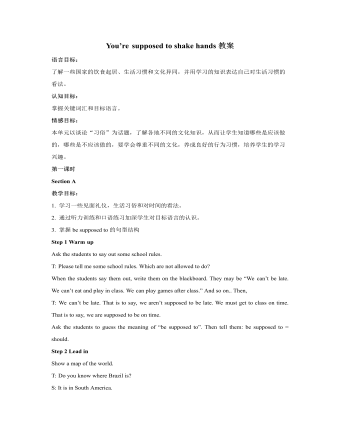
人教版新目标初中英语九年级下册You’re supposed to shake hands教案
教学目标:1. 掌握本单元一些重点词汇的写法和用法。2. 学会自如谈论餐桌礼仪。Step 1 RevisionAsk some students to retell the customs at the table in France in the passage in 3a.Step 2 Self checkPart 1. Fill in each bland with the correct word given. Students do the exercises by themselves at first. Then check the answers. Ask the students to comprehend the sentences and help them point out uses of some words, like “arrive (at / in) sw., spend time / money on sth , spend time / money (in) doing sth.”Part 2. Read about Fan Ling’s experience in a western restaurant. Understand the passage. Point out some key points in the passage.1. be / get used to doing sth. 习惯做某事2. begin with = start with 以….开头3. crowd v. 挤满,塞满 the crowd 人群 crowded adj. 拥挤的Then students discuss about how she would solve her problem. Ask some to share their stories with others.Part 3. Complete the crossword by looking at the sentences on the left. Then check the answers.
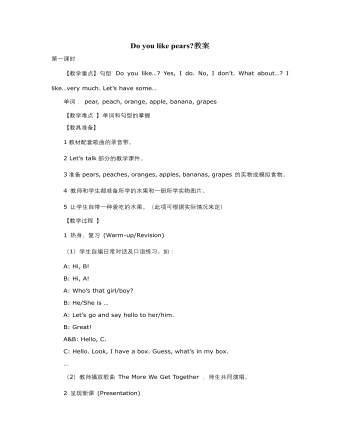
人教版新课标PEP小学英语三年级下册Do you like pears教案
教师扮做客人,让孩子根据问题做出反应并回答。 Can I have an apple? Can I have some grapes? Let’s sing 播放歌曲的录像,先观看一遍, 帮助孩子理解歌曲。 孩子边唱边表演。 小组表演,小组展示。 (四) 扩展性活动(Add-activities) Coloring Draw some grapes, color them red Draw a banana,color it green. …, …【板书设计 】Do you like pears? Do you like pears? 第五课时第六课时【课题】Do you like pears? 第六课时 【教学重点】听、说、认读字母Rr Ss Tt,体会字母在单词中的发音 【教学难点 】字母Ss的发音。Tiger中字母I的发音 【教具准备】 1、本课生词的单词卡片 2、配套的教学课件 3、相配套的教学录音带 4、学生的小英语练习本 5、大字母卡片,每组一套的小字母卡片 【教学过程 】 (一)热身/复习(Warm-up/Revision) 1、Let’s sing 演唱B部分的歌曲,边唱边演。

人教版新课标PEP小学英语五年级上册What Can You Do教案
1、能够听懂、会说:Can you ……?Yes, I can./No, I can’t, but I’d like to have a try!并能在情景中运用。2、能够完成Task time中的任务。教学重、难点:重点:Can you ……? Yes, I can./No, I can’t.难点:I’d like to have a try. 以及在实际情景中正确运用所学对话。课前准备:录音带、录音机、动作词卡教学过程:1、 热身(1) 放歌谣,学生边说边做相应的动作。(2) 将动词编入歌谣,有节奏地说唱。2、 预习(1) 听数字,报词组。(2) 做“少了什么?”游戏。(3) 学生拼读四会词组并仿写。3、 新授Let’s try(1)教师向学生展示挂图,放录音,学生用彩笔连线,完成练习。录音内容如下:①Boy: I can make the bed. I can do the dishes. And I can empty the trash.②Girl: I can sweep the floor. I can cook the meals. I can wash the clothes.Listen and link. Who are they?(2)教师检查并指导学生完成连线。(3)师生、生生问答操练:Can you ……?Yes, I can. /No, I can’t.Let’s talk(1)教师放录音,学生跟读。注意“but I’d like to have a try!”的发音和意思。(2)学生四人小组进行对话操练,然后上台表演对话。(3)请若干女生上台,做连锁问答游戏。
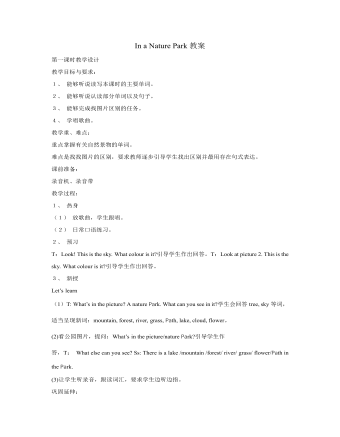
人教版新课标PEP小学英语五年级上册In a Nature Park教案
(3) 听录音,跟读。(4) 同桌之间,进行对话替换操练,然后先几组在班上说一说。(5) 听Let’s check.教师放录音。录音原文如下:Is there a lake in the nature Park?No, there is a river. The water is very clean.Are there any tall buildings in your village?No, there aren’t. There are only small houses.Is there a forest near your village? Yes, there is. There are many beautiful trees. Are there any bridges over the river? Yes, there are two bridges.巩固延伸:做配套练习;做“你猜我答”游戏;做Task time任务第六课时教学设计教学目标与要求:1、 能够听说读写本课句型及单词。2、 能用“There be…”句型介绍山村并描述其特征。教学重、难点:重点掌握句型的书写难点:单词的复数。课前准备:词卡、录音机、录音带教学过程:1、 热身(1) 日常口语练习。(2) 放录音,让学生跟着录音说唱。2、 预习做“拼单词”游戏。3、 新授Read and write(1) 看图,说:There are two pictures. What’s in the pictures? Listen.教师放录音,学生边听边阅读。(2) 学生就不懂的地方提问,教师解答。(3) 放录音,然后指导学生完成练习。(4) 指导学生书写四会句子。

人教版新课标PEP小学英语五年级下册What Are You Doing教案
教学参考时间:2—3分钟教师让学生说出几个家庭成员名称,如:father, mother, sister, brother, uncle等,自己或让学生把单词写在黑板的一侧,再让学生说出几个动词短语的-ing形式,如:washing clothes, writing an e-mail, watching TV等,写到黑板的另一侧。学生在家庭成员名称和动词短语中分别选三至四个,自己编成一首歌谣。课后,可以让学生将创作的歌谣进行展示或举行歌谣朗读比赛。5、Consolidation and extension (扩展活动)活动十:知识扩展教学参考时间:1—2 分钟教师让学生打开书第54页Good to know 部分,了解主要国家的紧急救助电话。如:美国,英国,加拿大,澳大利亚等。教师还帮助学生了解我国的紧急救助电话号码。教师可以利用道具电话让学生做游戏。活动十一:练一练教学参考时间:2—3 分钟做本单元B Let’s talk部分的活动手册第37页的配套练习。教师讲解题目要求。教师播放录音,做Listen and number 部分练习。要求按所听内容在图上写出序号。再次播放,让学生按录音内容填空。鼓励学生自己读读所写句子。
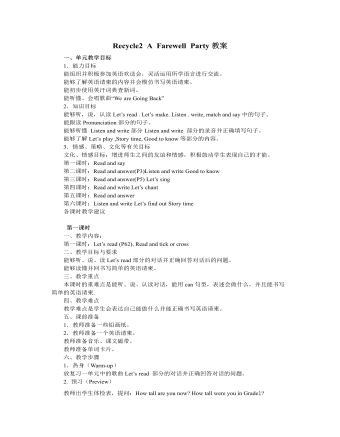
人教版新课标PEP小学英语六年级下册Recycle2 A Farewell Party教案
3. 新课呈现(Presentation) Let’s make (1)教师说:Miss White is making a book about her students. So she can remember them well.Who are the students? 请学生独立或分小组朗读四段短文,解释学生不理解的句子,然后说:There are four pictures below. Would you like to help Miss/White glue the pictures? 教师知道学生完成图文搭配的练习。 (2)教师发给每名学生一张铅画纸,说:Now please draw a picture of your best classmate. Then describe him or her.学生画一副最要好的同学的肖像,并在傍边配上对该同学的英语介绍。 学生上讲台介绍自己最要好的同学,请其他学生猜是谁,看谁说的生动又贴切,教师给予评价时注意强调第三人称单数形式的使用。 Story time 教师向学生展示Story time部分的教学挂图,指着最后一副图中的Zoom 和 Zip说 Look at the picture. Zoom and Zip are sad. They are saying goodbye to each other. Now let’s see What happened. 学生同桌之间合作阅读或是,然后教师提出问题Where is Zip going? Is this good news for zoom ? What grade is Zip going to be in? 教师放录音,学生录音跟读故事,然后再分角色朗读.
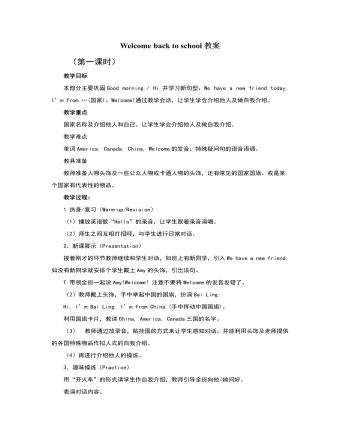
人教版新课标PEP小学英语三年级下册Welcome back to school教案
教学过程:1.热身/复习(Warm-up/Revision)(1)教师用肢体语言表示出字母,让学生猜出字母,并大声读出。(2)出示字母卡,学生认读,并提问学生回忆以它开头的单词。(3)放A部分Let’s chant的录音,学生有节奏地跟唱歌谣。2.新课展示(Presentation)(1)出示字母卡学习Dd,再单独呈现大写或小写,反复教读。用同样方法教读Ee。(2)出示以这两个字母为首字母的单词图片,问学生:What’s this ?回答:It’s a duck .教读duck,dog,egg,elephant。注意egg是an egg,不是“a egg”.(3)放Let’s say部分的录音,学生跟读。3.趣味操练(Practice)(1)呈现大写或小写字母的趣味图片,让学生认读。(2)让学生发挥想象,说出这些字母 像什么。(3)教师按笔顺书写字母,让学生观察后按笔顺书写字母。(4)游戏:找朋友游戏:看谁站得快学生手执卡片,听教师发令后,产成一排,下面的学生边读边检查。
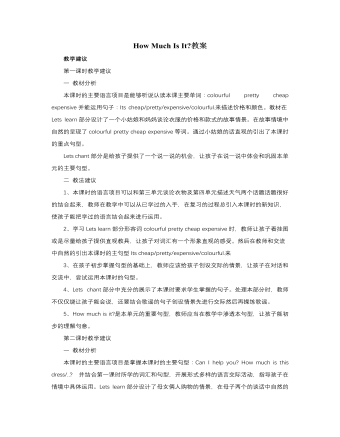
人教版新课标PEP小学英语四年级下册How Much Is It教案
一 教材分析本课时的主要语言项目是能够听说认读本课主要单词:colourful pretty cheap expensive并能运用句子:Its cheap/pretty/expensive/colourful.来描述价格和颜色。教材在Lets learn部分设计了一个小姑娘和妈妈谈论衣服的价格和款式的故事情景。在故事情境中自然的呈现了colourful pretty cheap expensive等词。通过小姑娘的话直观的引出了本课时的重点句型。Lets chant部分是给孩子提供了一个说一说的机会,让孩子在说一说中体会和巩固本单元的主要句型。二 教法建议1、本课时的语言项目可以和第三单元谈论衣物及第四单元描述天气两个话题话题很好的结合起来,教师在教学中可以从已学过的入手,在复习的过程总引入本课时的新知识,使孩子能把学过的语言结合起来进行运用。 2、学习Lets learn部分形容词colourful pretty cheap expensive时,教师让孩子看挂图或是尽量给孩子提供直观教具,让孩子对词汇有一个形象直观的感受。然后在教师和交流中自然的引出本课时的主句型Its cheap/pretty/expensive/colourful.来

人教版新课标PEP小学英语四年级下册What Time Is It教案
2. 看图片或课件,回答理解性问题,并通过情景、动作等帮助学生理解hurry, ready 和oops的意义,可适当进行造句练习加以巩固,并注意对两个句型:“It’s time for ...”和“It’s time to ...”加以比较。听录音,然后跟读、模仿。分角色朗读和分角色表演。(三)趣味操练 (Practice)1.调查:设计一个调查表,然后调查五名学生或教师的作息时间,在四人小组中进行交流。鼓励学生用新句型“It’s time to ...”来表述。2.Let’s check教师连续播放三次录音。第一遍让学生先听录音,第二遍勾出与录音内容相符的一项,第三遍检查并核对答案。教师引导学生自我评价。(四)扩展性活动(Add-activities)1.做本单元B部分Let’s talk的活动手册配套练习。2.将本课时对话读给同伴、朋友或家长听。3.用英语向好朋友介绍自己的作息时间表。
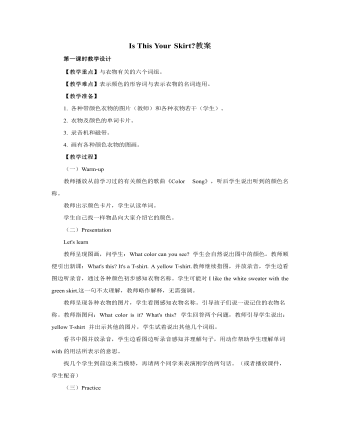
人教版新课标PEP小学英语四年级下册Is This Your Skirt教案
【教学过程】热身/复习(Warm-up/Revision)free talkWhat color do you like?What color is your /…?Let’s chantB部分的Let’s chant.的歌谣,边说边出示单词。(二)呈现新课 (Presentation)观看Let’s learn部分录像,理解情景。教师带读生词,让孩子认读。小组比赛拼读,抽查孩子的拼读。两人一小组,一个拼,一个写。单词的抄写练习。出示句子的句卡,让孩子试读,教师提示学生注意第一个单词第一个字母大写,提示孩子注意标点和占格。模仿课文内容,学生自己设计对话,进行表演。(三)趣味操练 (Practice)拼一拼,猜一猜教师拼一个单词,让孩子迅速说出词孩子小组做游戏听一听,拼一拼每个小组一套字母卡片,请一个孩子说词,小组拼,比比谁最快。Pass the message教师分别给每个小组一张句卡,“What color is it? ”各小组抄写传到最后一名同学,写出答案。(四) 扩展性活动(Add-activities)设计你心目中的时装:每个孩子设计一套衣服,给自己的娃娃穿上,然后运用本单元学过的句子进行介绍。
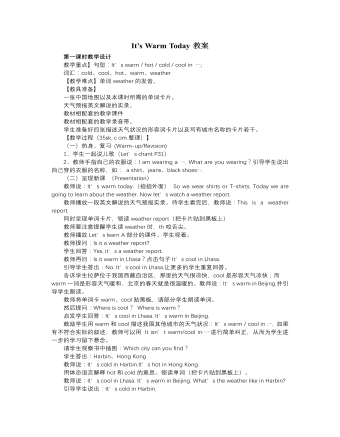
人教版新课标PEP小学英语四年级下册It’s Warm Today教案
1、Read and Write部分的课件及录音。 2、Pronunciation部部分的录音。 3、单词卡片:sunny,warm,cold,snowy,cool,cold, cloudy, hot, rainy, windy。 【教学过程 】 (一)热身、复习 (Warm-up/Revision) 出示单词卡:warm,hot,cool,cold,rainy,snowy,windy,sunny,cloudy,学生集体朗读。 请学生打开书P52,看记录回答教师问题: 教师提问:What’s the weather like in Beijing? What’s the weather like in Shanghai? 请4位学生分别提问Harbin,Lhasa,Urumqi,Hongkong的天气,大家回答。 请学生朗读P51对话后的句子:It’s cool. 在本上认真书写句子It’s cool. 教师要巡视检查。 (二)呈现新课 (Presentation) A. Lead-in 请学生继续看记录,教师提问: Is it warm in Beijing? Is it snowy in Harbin? Is it cool in Shanghai? Is it windy in Lhasa? Is it cold in Urumqi? Is it hot in Hong Kong? 引导学生根据记录用Yes, it is. 或No, it isn’t. 回答。 请学生用Is it…?分别猜一猜London,Sydney,Singapore,Moscow的天气,教师前一天根据天气预报情况用Yes, it is. 或No, it isn’t. 回答学生的提问。 请学生朗读P51对话后的句子:Is it cold?并说出意思。 学生在本上规范书写句子Is it cold?教师提示学生注意标点是?。
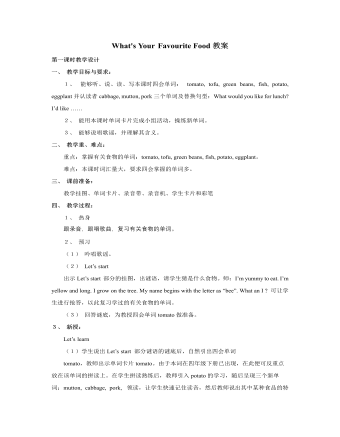
人教版新课标PEP小学英语五年级上册What's Your Favourite Food教案
教读句子:What’s your favourite food?(2)两人小组用该句型编一小段对话进行操练,同时也可引导学生用该句型编一小段对话进行操练,同时也可引导学生用fruit and drink替换food.(3)听录音,让学生跟读对话。学生可用不同的食物单词做替换回答问句。Pair work让学生拿出已发的调查表格,用所学句型对不同学生进行调查,并要求对方陈述原因。先组内汇报,再向全班汇报,汇报时要说出:I like …… Mike likes…… We like……教师看哪一小组表现好,适当给予奖励。Task time请学生拿出第一课时所做的谜语卡片,向全班展示。巩固延伸:做配套练习,读对话给家长听,熟记单词第六课时教学设计教学目标与要求:1、能够听、说、读、写本课时四会句子:What’s your favourite fruit?I like apples. They’re sweet. I don’t like grapes. They’re sour.并能在情景中正确运用。能够在Group work中使用该句型完成调查。2、能够理解情景对话的含义并完成句子填空。3、能够理解Pronunciation中字母组合的发音规则,读出相关的单词。

